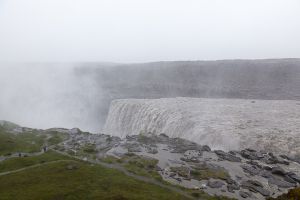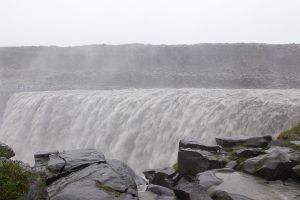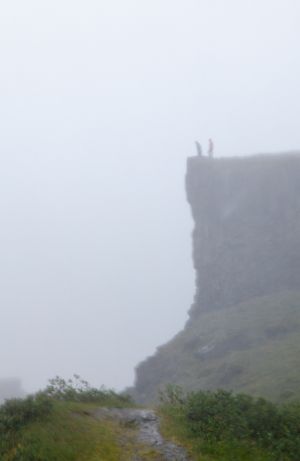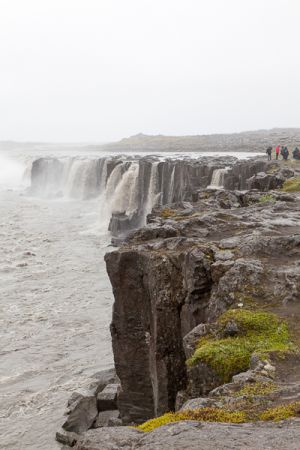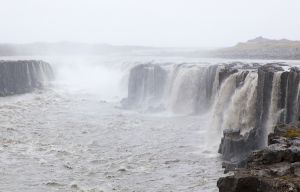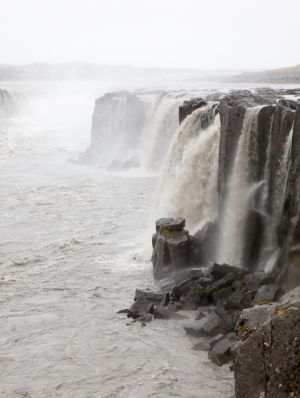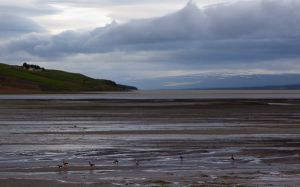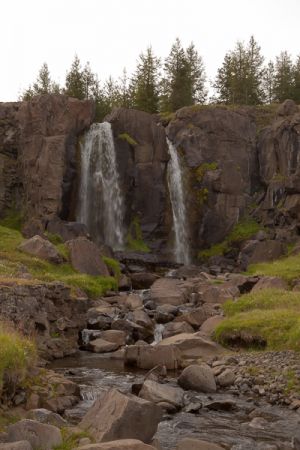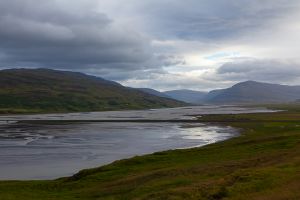Still drizzling this morning, and the wind hasn’t let up as I head from Lake Myvatn to Egilsstaðir. I have one attempt at photographing birds around Lake Myvatn and quickly give up – dark birds on grey water with light grey sky isn’t attractive. I decide to detour to Dettifoss on the way to Egilsstaðir. Dettifoss is the most powerful waterfall in Iceland, if not Europe, and the car park is pretty full on arrival.
It is absolutely freezing and raining at Dettifoss. I have to pull the waterproof trousers out of the suitcase and retrieve the Arctic expedition parka as well. Hat and gloves are the order of the day, and it is misty and overcast as well. I take one look at the weather and decide to leave the tripod in the boot. It is blowing so hard the tripod won’t make any difference.
It’s hard to get a good look at Dettifoss – the viewing platform is slightly above the falls, and (today anyway) it’s not possible to see more than the top section.
The driving rain probably isn’t helping. Any delusions I had about lovely sunlit waterfalls are gone. It’s cold and raining, but at least I’m dry and relatively warm, at least compared to one guy I see in jeans and a fleece, who’s in for an uncomfortable ride to wherever he’s going next.
Selfoss, the smaller waterfall a short walk along the headland away, is easier to manage. The rain has eased off a bit, and there isn’t the same degree of spray coming off the waterfall. I’m glad I’ve got a change of shoes in the boot of the car. Some tour bus patrons are in for a wet ride to the next stop.
Heading to Egilsstaðir, on the east coast of Iceland, there’s a barren stretch of about 100km. No farms, no sheeps, no petrol stations, no radio reception, nada. All there is is low lying mist and drizzle. About 40 km out from Egilsstaðir, a broad valley opens out, farms start to appear, sheep and horses magically appear, and the mist disappears.
Egilsstaðir is famous for having it’s version of the Loch Ness monster living in it’s fjord. The English language translation on the sign I read calls it a ‘worm monster’, first sighted in the 1840s. Anything that has survived for more than 160 years has it’s head and body under water in the fjord today, where it’s probably warmer. The wind has picked up again, and is so strong when I stop on a bridge over the fjord (one of the benefits of no traffic) that I can’t open the car door. It’s about 7 degrees Celsius, but the wind chill takes it below zero.
The town is small, but has a fabulous café called “Salt”, where I stop for lunch at about 4pm. They do a mean hot chocolate and a great flatbread pizza-style dish they call ‘health breads’. Breakfast was at 9am, so I don’t really care what they call it :-). It’s so good I go back for dinner.
Tonight’s accommodation is at the Hotel Edda. It’s an interesting setup – it’s a boarding school outside of summer, and during summer holidays the dorm rooms are converted to hotel rooms. I’m given a disabled access room, which is large and bright, with a private bathroom and two single beds pushed together. I’m not sure I’d elect to stay here, but it’s light and clean and seems okay for one night. Reflecting it’s use during the rest of the year, it has the best storage I’ve seen so far in a hotel room in Iceland, and has a proper desk that isn’t cluttered with a 20 year old TV :-). The hotel also has a restaurant, which I imagine reverts back to the school dining room during term time. It’s an innovative idea, and the end result probably better than the more ‘mainstream’ chain hotels, other than the odd feeling of being back at high school.

